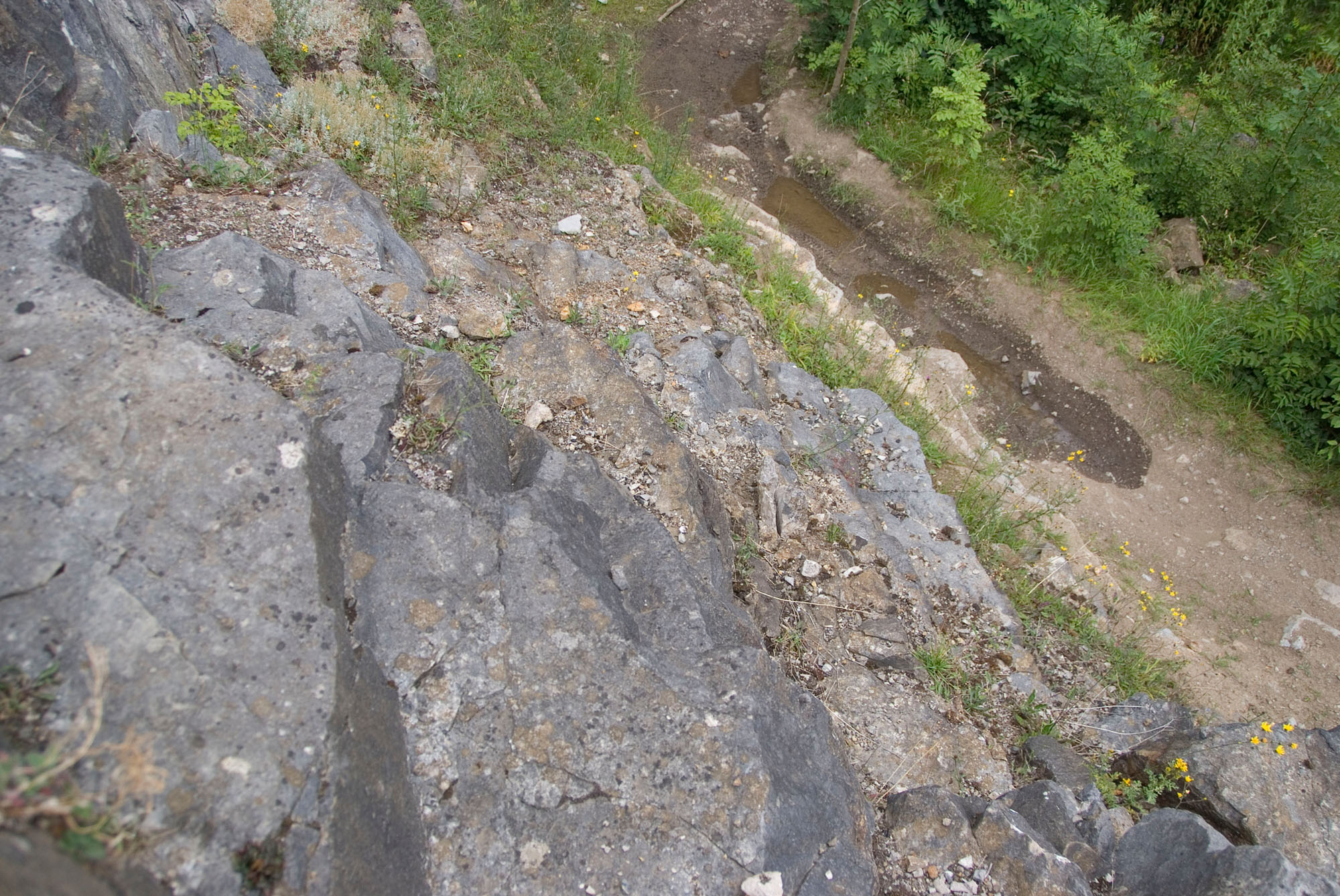In this large, disused quarry, not only can you see plenty of fossils, but the site is rich in the minerals, galena, fluorite and calcite. It has very steep sides, with plenty of rocks to look through around the edges of the quarry.
DIRECTIONS
♦ Butts Quarry can be found in the village of Ashover, to the northeast of Matlock. Follow the A632 from Matlock and turn off to Ashover at Kelstedge. Follow this road until you pass a hairpin bend with public footpaths to the left and right. This is actually where you will walk to, but, for parking, continue until you reach a road to the left where the local school is.
♦ From here, walk back to the hairpin bend. On your left (west), you should see a large double gate, with a public footpath to the right. Do not follow this. The footpath turns into the woods on the left, but instead, you need to continue straight ahead. After you have passed the wooded area on the left, you will see the large quarry.
♦ Do not park on the field or drive through the gates. These are often locked after use and incidents have occurred in which people have been unable to get out. Therefore, only park using the instruction given in this guide.
♦ Ref: 53.163973, -1.491790
PROFILE INFO
FIND FREQUENCY: ♦♦♦♦ – Fossils are very common at this quarry. Search the fallen blocks around the sides of the quarry. You can also find several minerals at this location, including fluorite (which is very similar to Blue John in colour), galena and calcite. However, although the owners do not mind rock enthusiasts coming onto their land to look at the rocks and fossils, this is still private property and collecting should be kept to a minimum.
CHILDREN: ♦♦♦ – This site is suitable for older children under adult supervision, as this is a large open quarry with a flat, overgrown floor. Loose rocks can be found all around the edges to look through.
ACCESS: ♦♦♦♦ – Access is very good. There is a bit of a walk from the safe parking area, down the road and across the field to the quarry, but it is easy going.
TYPE: – This is a large, disused quarry, next to a public footpath. Fossils and minerals can be seen in the rocks around the quarry. The quarry floor is now overgrown, but there are plenty of fallen blocks around the perimeter to look through.
This location is along a public footpath and there are no restrictions on entering the quarry, but please follow our general fossil code. However, although the owners do not mind rock enthusiasts coming onto their land to look at the rocks and fossils, this is still private property and collecting should be kept to a minimum.
FOSSIL HUNTING
Crinoid stem pieces, corals, bryozoans, bivalves and brachiopods can all be found here. Butts Quarry is an extremely interesting location; it is fascinating for anyone with an interest in geological features, minerals and/or fossils. For minerals, galena, calcite, fluorite and barytes can be all found here in veins and strings (see above). Volcanic tuff also sits beneath the quarry floor, with fragments occurring in the lower beds.
This is an excellent location for fossils. Most of the best are found in the higher Eyam Limestone beds. Corals, including Lithostrotion sp., Diphyphyllum sp. and Lonsdaleia sp., can be found in excellent condition, along with crinoids and brachiopods, including gigantoproductids.
Along the north-eastern wall, some beds of a lighter and more fragile limestone can be found. These have some excellent corals, but tend to be very poorly preserved. The best fossils can be found in the south-eastern corner, in a much harder limestone. The rest of the quarry is more overgrown and is not as productive as the eastern side.

GEOLOGY
The Carboniferous Limestone at Butts Quarry consists of Monsal Dale Limestone Group rocks and the Eyam Limestone Formation, both of Brigantian age from Visean Stage of the Dinantian (Lower Carboniferous) and part of the Peak Limestone Group.
This latter bed dips 15 degrees to the northwest and the total thickness here is 38m. The Eyam Limestone is the most fossiliferous, and is more massively bedded and darker than the underlying massive beds of the Monsal Dale Limestone.
Beneath the quarry floor, volcanic tuff is present. The basal limestone contains volcanic fragments and has been altered to a pale green colour.


SAFETY
As the quarry itself is not on the public footpath, you should be aware that you enter at your own risk. In addition, it has very steep and unstable faces. These are still crumbling, so it is best to keep away from them. Also, resist the temptation to climb up to reach higher beds, as the rock is too unstable for climbing.
EQUIPMENT
Bags for any loose fossils are useful and a small hammer should be taken to break the smaller rocks, but should not be used on the bedrock.
ACCESS RIGHTS
This location is along a public footpath and there are no restrictions on entering the quarry, but please follow our general fossil code. However, although the owners do not mind rock enthusiasts coming onto their land to look at the rocks and fossils, this is still private property and collecting should be kept to a minimum.
It is important to follow our ‘Code of Conduct’ when collecting fossils or visiting any site. Please also read our ‘Terms and Conditions‘
LINKS
♦ Buy Fossils, Crystals, Tools
♦ Location Discussions
♦ Deposits Magazine
♦ Join Fossil Hunts
♦ UK Fossils Network










































